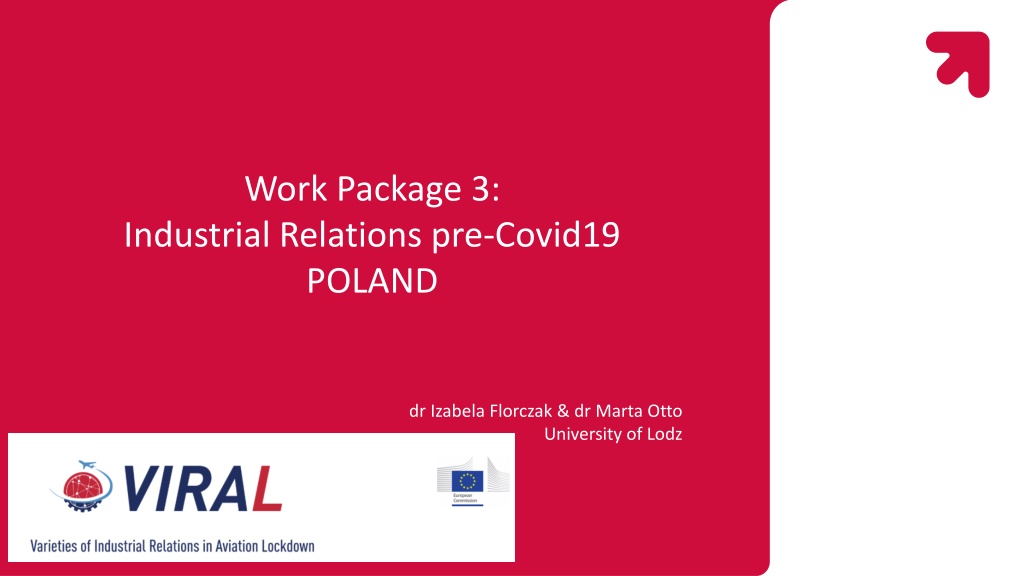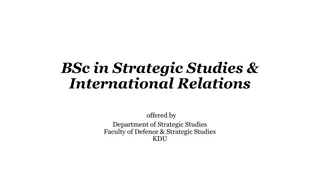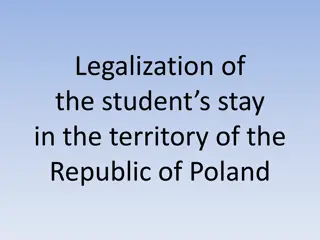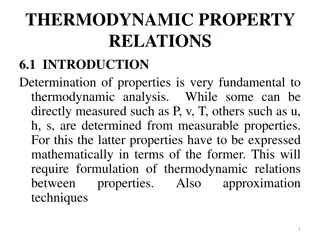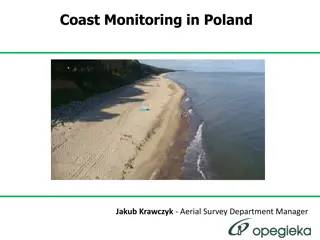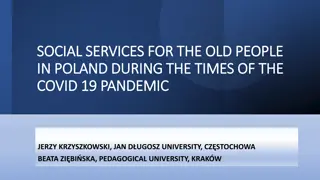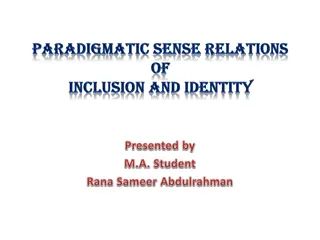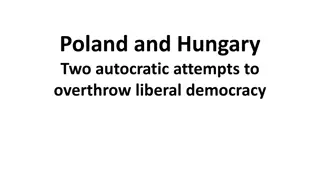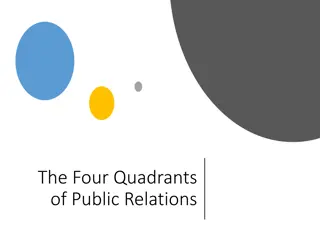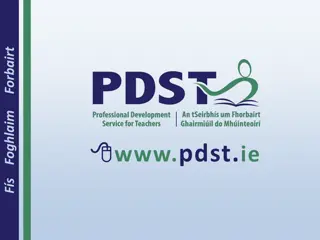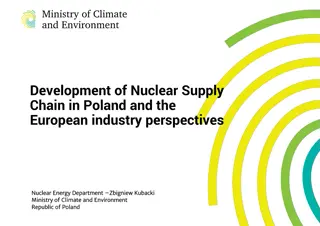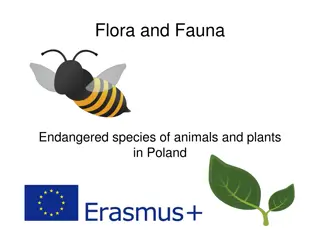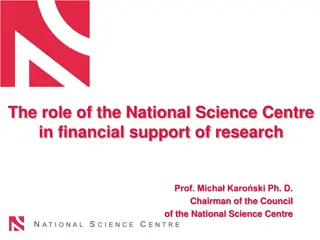Industrial Relations in Poland: Pre-COVID-19 Overview
Industrial relations in Poland provide insight into trade union membership, employment contracts, and the landscape for self-employed individuals. The country has seen amendments to trade union laws, granting rights to join unions for various employment types. Trade unions play a significant role, with three national organizations and a prevalence in the public sector. Various levels of trade union organizations exist within different sectors.
Download Presentation

Please find below an Image/Link to download the presentation.
The content on the website is provided AS IS for your information and personal use only. It may not be sold, licensed, or shared on other websites without obtaining consent from the author. Download presentation by click this link. If you encounter any issues during the download, it is possible that the publisher has removed the file from their server.
E N D
Presentation Transcript
Work Package 3: Industrial Relations pre-Covid19 POLAND dr Izabela Florczak & dr Marta Otto University of Lodz
PART 1 General overview of Industrial Relations in POLAND pre-COVID-19
Industrial relations in Poland: background summary Trade union membership employment contracts 17% of those who are employed on the basis of 11% of all people in employment According to the law on 5.07.2018 (amendment of Trade Union Act from 23.05 1991) from 1.1.2019 the right to join and create trade union is being granted to people employed outside labour law (on the grounds of civil law contracts) and people who are self-employed 17.10.2021 first trade union of self-employed wBREw
Industrial relations in Poland: background summary About wBREw: We are a trade union for the self-employed that supports its members. We are entrepreneurs who are fed up with a predatory state, over-taxed and underpaid pensions. We stand for equality of all economic entities before the law and the tax authorities. We do not agree with the exploitation of the self-employed by corporations, market monopolies and the state. We are against discriminatory laws and compulsory self-employment. We are for a strong organisation of the self- employed. We are self-employed.
Industrial relations in Poland: background summary Trade unions main actors: There are three national trade union organisations, including two confederations: OPZZ- the All-Poland Alliance of Trade Unions - Og lnopolskie Porozumienie Zwi zk w Zawodowych, NSZZ Solidarno the Independent and Self-Govering Trade Union -Niezale ny Samorz dny Zwi zek Zawodowy Solidarno FZZ the Trade Unions Forum - Forum Zwi zk w Zawodowych, which includes 75 trade union organizations. According to GUS there are around 12,900 active trade union organisations
Industrial relations in Poland: background summary Trade unions: Trade unions are far more common occur in the public sector (62%) than in the private sector (38%)
Industrial relations in Poland: background summary Trade unions: Within all trade unions operated: company, sub-company and branch trade union organizations 78.1% inter-company trade union organizations 19.5% federations, confederations and unified trade unions 2.3% trade unions of individual farmers 0.1% company, sub-company and branch trade union organizations inter-company trade union organizations inter-company trade union organizations federations, confederations and unified trade unions trade unions of individual farmers
Industrial relations in Poland: background summary Main legal acts: THE CONSTITUTION OF THE REPUBLIC OF POLAND, 2 April 1997 Article 12 The Republic of Poland shall ensure freedom for the creation and functioning of trade unions, socio-occupational organizations of farmers, societies, citizens' movements, other voluntary associations and foundations. Labour Code of 26.06.1974 (regulation on collective agreement) Act on Trade Unions of 23 May 1991 Act on Collective Dispute Resolution of 23.05.1991
Industrial relations in Poland: background summary Trade unions or work counsils: Act on informing and consulting employees of 7.04.2006 Even though there is a dual channel of employee representation, trade unions remain the main platform for employees to have a voice, as works councils have largely failed to become embedded in the national industrial relations landscape.
Since 2006, 3671 entities have notified the establishment of workcouncils. Number of notifications by year: year I TERM II TERM III TERM IV TERM 2006 2007 2008 2009 2010 2011 2012 2013 2014 2015 2016 2017 2018 2019 2020 2021 1903 213 786 129 148 73 89 49 46 57 34 43 47 23 18 12 - - - 2 362 142 117 25 83 36 25 11 22 34 9 7 - - - - - - - 1 153 86 49 23 43 13 6 8 - - - - - - - - - - - 1 67 41 14 7
Industrial relations in Poland: background summary Collective agreements: single employer collective labour agreements (zak adowy uk ad zbiorowy pracy, SECA) - concluded by employer and representative trade unions multi-employer collective (ponadzak adowyuk ad zbiorowy pracy, MECA) concluded by the appropriate statutory body of a multi-enterprise trade union, acting for the employees, and the appropriate statutory body of an employers association, acting for the employers, on behalf of the employers united in the association labour agreements
Industrial relations in Poland: background summary Collective agreements: by the end of 2015: 8,032 SECAs had been registered, covering nearly 1.8 million workers, of whom slightly above 1 million were employed in the public sector, and nearly 800,000 in the private sector; 86 MECAs covering 390,000 employees
Industrial relations in Poland: background summary Rada Dialogu Spo ecznego - Social Dialogue Council: The tripartite dialogue engages the representatives of 1. employees, 2. employers and 3. government in the discussion on the public issues, projects of legal solutions and other decisions taken, concerning the interests of the employers and employees.
PART 2 Industrial Relations in aviation in Poland pre-COVID-19
Industrial Relations in aviation in Poland pre-COVID-19 Who are the main actors in aviation? Polskie Linie Lotnicze "LOT" S.A. (PLL LOT, PLL "Lot") - Polish national airline, established on 29 December 1928 under the name of Linie Lotnicze LOT Sp. z o.o. from a merger of - operating in the country - private airlines Aerolot and Aero, as a result of their nationalisation. It began actual operations on 1 January 1929 and is one of the world's oldest operating airlines.
Industrial Relations in aviation in Poland pre-COVID-19 Who are the main actors in aviation? Polska Grupa Lotnicza, PGL (Polish Aviation Group) - the largest airline company in Poland, with its registered office in Warsaw, owner of LOT Polish Airlines SA, LOT Aircraft Maintenance Services sp. z o.o. (LOTAMS), LS Airport Services SA. (LSAS) and LS Technics sp. z o.o. (LST).
Industrial Relations in aviation in Poland pre-COVID-19 Who are the main actors in aviation? Polska Agencja eglugi Powietrznej - Polish Air Navigation Services Agency - state legal person, a unit of the public finance sector, which finances its basic activity from navigation charges paid by airspace users. The Agency is subject to the supervision of the President of ULC (Urz d Lotnictwa Cywilnego) and the Minister competent for transport.
Industrial Relations in aviation in Poland pre-COVID-19 Who are the main actors in aviation? Urz d Lotnictwa Cywilnego Civil Aviation Authority - a state budgetary unit serving the President of the Civil Aviation Authority who administration body responsible for civil aviation matters. is the central government
Industrial Relations in aviation in Poland pre-COVID-19 Who are the main actors in aviation? President of the Civil Aviation Authority The competence of the President of the Office includes all matters relating to civil aviation, with the exception of matters reserved by acts and international agreements for the minister responsible for transport matters or other public administration authorities. The President of the Office shall exercise aviation supervision and shall be an aviation authority within the meaning of international agreements.
Industrial Relations in aviation in Poland pre-COVID-19 Who are the main actors in aviation? Przedsi biorstwo Pa stwowe Porty Lotnicze "Polish Airports" State Enterprise - a Polish state-owned company involved in the construction, modernisation and operation of airports and aviation ground facilities, including ground handling of aircraft at Warsaw Chopin Airport.
Industrial Relations in aviation in Poland pre-COVID-19 Who are the main actors in aviation? Labour unions Polish Airlines LOT Trade Union Civil Aviation Workers' Union (Zwi zek Zawodowy Polskich Linii Lotniczych, PLL LOT SA) (Zwi zek Zawodowy Pracownik w Lotnictwa Cywilnego) Cabin Crew Trade Union Mechanics Trade Union Aircraft Maintenance Staff Trade Union (Zwi zek zawodowy naziemnego personelu lotniczego) Trade Union of Air Traffic Controllers (Zwi zek Zawodowy Kontroler w Ruchu Lotniczego) Polish National Trade Union of Air Traffic Services Ruchu Lotniczego) (Zwi zek Zawodowy Personelu Pok adowego) (Zwi zek Zawodowy Mechanik w) (Og lnopolski Zwi zek Zawodowy S u b Airline Pilots Trade Union Transport Pilots Trade Union (Zwi zek Zawodowy Pilot w Komunikacyjnych) (Zwi zek Zawodowy Pilot w Liniowych)
Industrial Relations in aviation in Poland pre-COVID-19 Who are the main actors in aviation? Labour unions TRAFFIC CONTROLLERS: PODKARPACKIE UNION OF AIR TRAFFIC CONTROLLERS UNION OF AIR TRAFFIC CONTROLLERS AT POZNA - AWICA AIRPORT WESTPOMERANIAN UNION OF AIR TRAFFIC CONTROLLERS IN LIQUIDATION UNION OF AIR TRAFFIC CONTROLLERS 'CENTRUM
Industrial Relations in aviation in Poland pre-COVID-19 How has the financial situation and employment situation in aviation in your country developed prior to COVID-19? report on the organization and financing of training at the Polish Air Navigation Services Agency by Supreme Audit Office: 2012-2016 - significant shortages in the employment of air traffic controllers The industry is currently experiencing a shortage of staff not only in pilots and cabin crew, but above all in ground handling staff and specially qualified technicians. This coincides with a relatively low level of interest in this sector among young people who are just starting out on their careers - they rarely choose aviation-related schools and courses. [2021]
Industrial Relations in aviation in Poland pre-COVID-19 How has the financial situation and employment situation in aviation in your country developed prior to COVID-19? [2019] EARNINGS: best paid position at an airport - Airport Security Guards 3 900 to 6 640 PLN gross per month airport dispatcher - 10 000 to 14 000 PLN gross per month (the requirements are higher and include passing an exam, a licence, and entry in the national register of aviation personel) dreamliner pilots - 20 000 to 30 000 PLN gross per month PLL LOT stewardess - 5 000 to 10 000 PLN gross per month
Industrial Relations in aviation in Poland pre-COVID-19 The aviation sector in Poland employed about 67 000 people in 2019. Nearly 30 000 people worked in indirectly related industries, i.e., those producing or providing services to the sector.
Industrial Relations in aviation in Poland pre-COVID-19 Special regulation Motion to establish at the level of Social Dialogue Council - Tripartite Sectoral Team for Air Transport and Airport Services
Collective agreement for PLL LOT employees Form 14.03.1975
Industrial Relations in aviation in Poland pre-COVID-19 RYANAIR 10.09.2018 - The Solidarity trade union organisation at Ryanair DAC was registered (as SECA) Ryanair DAC pulled out of Poland from 1 January 2019, with Warsaw Aviation to take its services in its place. Irish low-cost carrier Ryanair has obliged its employees to become self-employed and sign a cooperation agreement with Warsaw Aviation. This meant depriving on-board crew members, among other things, of social protection from their current employer and drastically reducing future pension benefits. Members of the trade union who, in order to keep their jobs, belatedly decided to sign the unfavourable agreement for them - were refused by the employer. According to a member of the union s board it was an attempt to liquidate the trade union in the company.
Industrial Relations in aviation in Poland pre-COVID-19 COLLECTIVE DISPUTE 2016 - the Management Board of PLL LOT has reached an agreement with trade unions that suspended the collective dispute that has been going on for nearly two years and introduced temporary Remuneration Regulations that was in force throughout 2016. 2019 - the Management Board of PLL LOT and representatives of the Trade Union of Flight and Airline Personnel and the Transport Pilots Trade Union have reached agreement on the financial terms of the new Remuneration Regulations. The signed agreement ended a collective dispute which has been going on in the company for six years.
Industrial Relations in aviation in Poland pre-COVID-19 THE CONTROL OF NATIONAL LABOUR INSPECTORATE controlled the working time and employment basis of cabin crew used by the carrier After the audit, it was requested that civil law contracts should not be used in conditions that are typical of employment relationships. Cabin crew, namely pilots, stewards and stewardesses, are employed on different bases - employment contracts and civil law contracts as self- employed - although they carry out the same duties.
Industrial Relations in aviation in Poland pre-COVID-19 NEW PATHS [2020] The pathologies in labour relations had accumulated in aviation companies to an exceptional degree. Examples include the attempted disciplinary dismissal of 67 pilots during the Lot strike, the threat of lawsuits for protest actions using external law firms, and the employment of flight crew members on civil law contracts. Trade unionists are strongly accusing the management of their companies of unwillingness to engage in social dialogue and even of failing to inform about the most important issues for employees, such as the future of the company in which they work.
